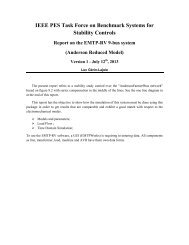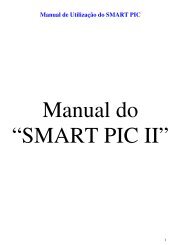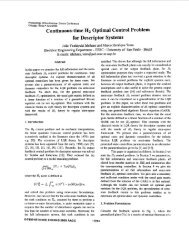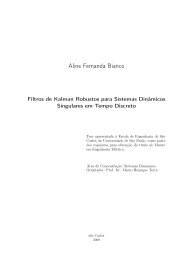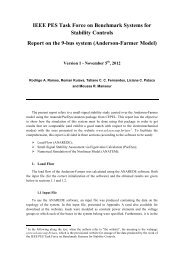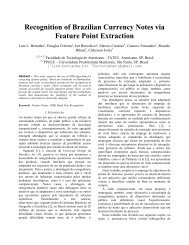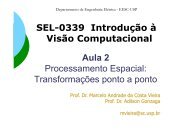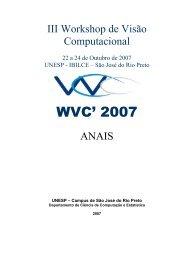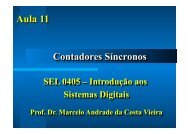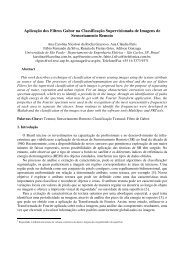A Comparison of Histogram and Template Matching for Face ...
A Comparison of Histogram and Template Matching for Face ...
A Comparison of Histogram and Template Matching for Face ...
You also want an ePaper? Increase the reach of your titles
YUMPU automatically turns print PDFs into web optimized ePapers that Google loves.
SPORTSMANSHIPThe Independence School District is a member <strong>of</strong> the Greater Kansas City Suburban Conference<strong>and</strong> Missouri State High School Activities Association (MSHSAA). As members <strong>of</strong> thesegroups, we adhere to policies set down <strong>for</strong> the display <strong>of</strong> good sportsmanship by athletes,students, fans, parents <strong>and</strong> patrons. Member schools are to en<strong>for</strong>ce sportsmanship rules <strong>for</strong> ourown school, players <strong>and</strong> spectators. Violation <strong>of</strong> rules can result in the following consequences:written reprim<strong>and</strong>, probation, suspension, ejection or permanent removal from events.Consequences are in <strong>for</strong>ce <strong>for</strong> players, coaches, students, parents <strong>and</strong> fans.All school discipline policies <strong>and</strong> rules apply to the Independence School District students atschool activities whether they are held on school property or away from school.GOOD SPORTSMANSHIP CODEFor Players, Coaches <strong>and</strong> Fans1. Maintain pride in self <strong>and</strong> school.2. Strive to keep high st<strong>and</strong>ards <strong>of</strong> conduct.3. Cheering is always encouraged <strong>for</strong> one’s own team.4. No taunts, chants, noises, cheers, songs, pr<strong>of</strong>anity, signs or motionsdirected to the opposing team, coach, school or <strong>of</strong>ficials. Treat everyone with respect.5. Positive signs may be displayed <strong>for</strong> one’s own team.6. No disrespect will be shown to the opposing team during introductions.7. No noisemakers.8. No continuous st<strong>and</strong>ing.9. Abide by the decisions <strong>of</strong> <strong>of</strong>ficials.10. Accept victory or defeat graciously.The Independence School District does designate a student spirit section where st<strong>and</strong>ing ispermitted.The Independence School District grounds (inside <strong>and</strong> outside) are, by the Independence SchoolDistrict Board policy, a tobacco-free environment. There is to be no smoking inside the buildingor outside on any school or athletic grounds.4
Rotation Image TM <strong>Histogram</strong>in degrees−20 Figure 5(a) 0.8893 0.9750−10 Figure 5(b) 0.9235 0.9935−5 Figure 5(c) 0.9455 0.99750 Figure 1 1.0000 1.0000+5 Figure 5(d) 0.9506 0.9992+10 Figure 5(e) 0.9243 0.9945+20 Figure 5(f) 0.8847 0.9574Table 5. Similarity values <strong>of</strong> rotated face images.Translation TM <strong>Histogram</strong> Variation inin pixelsSimilarity6 (X) 0.9598 0.9913 3.3%4 (X) 0.9677 0.9963 3.0%2 (X) 0.9760 0.9965 2.1%0 1.0000 1.0000 0.0%2 (Y) 0.9790 0.9992 2.1%4 (Y) 0.9662 0.9966 3.1%6 (Y) 0.9565 0.9879 3.3%Table 6. Similarity values <strong>of</strong> translated faceimages (X <strong>and</strong> Y directions).(a) (b) (c)Figure 6. Sample translated images in X <strong>and</strong>Y directions (shown by dark lines).(d) (e) (f)Figure 5. Sample rotated images.A global assessment <strong>of</strong> all experiments is shown in Table7, where it can be seen that <strong>for</strong> images that involve geometrictrans<strong>for</strong>mations, HM is the best method, <strong>and</strong> it isalso suitable <strong>for</strong> images with Gaussian blur. Since the averagevariation in similarity values between HM <strong>and</strong> TM <strong>for</strong>Gaussian blur is about 1.0%, it can rougly be concluded thatboth methods are suitable <strong>for</strong> this disturbing factor. The previousconclusion regarding HM confirms that histogramsare invariant to rotation <strong>and</strong> translation, as mentioned inSection 3. At the same time, TM produces the best per<strong>for</strong>mancewhen dealing with RGB noise <strong>and</strong> different lightingconditions. As shown in Table 7, the average variation <strong>of</strong>similarity values is most significant <strong>for</strong> changes in lightingconditions when compared to other image variations. Figures7 <strong>and</strong> 8 summarize the brief discussion in this section.These graphs were plotted using the variation in similarityvalues between TM <strong>and</strong> HM <strong>for</strong> each image – the graphin Figure 7 regards images with added noise <strong>and</strong> changes inlighting, <strong>and</strong> the graph in Figure 8 regards images with ge-ometric trans<strong>for</strong>mations. From these graphs, it can be easilyseen that different lighting conditions <strong>and</strong> rotation resultin significant similarity variations between TM <strong>and</strong> HM.Image Best Average VariationVariation Method in SimilarityGaussian blur <strong>Histogram</strong> 1.0%RGB noise TM 6.5%Lighting TM 20.7%Scaling <strong>Histogram</strong> 2.7%Rotation <strong>Histogram</strong> 6.2%Translation <strong>Histogram</strong> 2.4%6. ConclusionTable 7. Per<strong>for</strong>mance comparison.In this work, TM based on cross-correlation <strong>and</strong> histogramswere used to compare face images. In real-worldapplications, images may have variations due to noise, lightingconditions, scaling, rotation <strong>and</strong> translation. To underst<strong>and</strong><strong>and</strong> analyze the influence <strong>of</strong> image variations in theface verification process, TM <strong>and</strong> HM methods were compared.Both methods are dependent on the value <strong>of</strong> im-
color distribution <strong>and</strong> are suitable <strong>for</strong> face recognition <strong>and</strong>related tasks, when dealing with image influenced by disturbingfactors more investigation using local image in<strong>for</strong>mationis needed.ReferencesFigure 7. Variation in similarity values betweenTM <strong>and</strong> histogram <strong>for</strong> Gaussian blur,RGB noise <strong>and</strong> illumination variation.Figure 8. Variation in similarity values betweenTM <strong>and</strong> histogram <strong>for</strong> scaling, rotation<strong>and</strong> translation.age pixels – TM depends on the local pixel in<strong>for</strong>mation,mean HM on the global pixel in<strong>for</strong>mation <strong>of</strong> the face images.According to the comparison <strong>of</strong> methods applied tothe face object image <strong>and</strong> different target face images usedin this work, TM can be considered as a suitable method<strong>for</strong> images with RGB noise, Gaussian blur <strong>and</strong> images withslight variations in lighting conditions, <strong>and</strong> HM <strong>for</strong> face imagesunder different geometric trans<strong>for</strong>mations. As a generalconclusion, it can be pointed out that images withchanges in illumination require more investigation so thatthe most suitable matching method <strong>for</strong> face verificationcan be determined. In this work, global histograms <strong>of</strong> theRGB color channels were analyzed <strong>for</strong> face verification. Althoughglobal histograms capture <strong>and</strong> represent the image[1] J. R. Beveridge, G. H. Givens, P. J. Philips, B. A. Draper, <strong>and</strong>Y. M. Lui. Focus on quality, predicting FRVT 2006 per<strong>for</strong>mance.In Proceedings <strong>of</strong> the 8th IEEE International Conferenceon Automatic <strong>Face</strong> <strong>and</strong> Gesture Recognition, pages1–8, 2008.[2] G. Bradski <strong>and</strong> A. Kaehler. Learning OpenCV. O’Reilly Media,2008.[3] R. Brunelli <strong>and</strong> T. Poggio. <strong>Template</strong> matching: Matched spatialfilters <strong>and</strong> beyond. Pattern Recognition, 30(5):751–768,May 1997.[4] G. D. Finlayson, S. S. Chatterjee, <strong>and</strong> B. V. Funt. Color angularindexing. In Proceedings <strong>of</strong> the 4th European Conferencein Computer Vision, pages 16–27, 1996.[5] R. C. Gonzalez <strong>and</strong> R. E. Woods. Digital Image Processing.Prentice Hall, 3rd edition, 2009.[6] H. Guo, Y. Yu, <strong>and</strong> Q. Jia. <strong>Face</strong> detection with abstracttemplate. In Proceedings <strong>of</strong> the 3rd International Congresson Image <strong>and</strong> Signal Processing, volume 1, pages 129–134,2010.[7] W. Jia, H. Zhang, X. He, <strong>and</strong> Q. Wu. A comparison on histogrambased image matching methods. In Proceedings <strong>of</strong>the 3rd IEEE International Conference on Video <strong>and</strong> SignalBased Surveillance, pages 97–102, 2006.[8] Z. Jin, Z. Lou, J. Yang, <strong>and</strong> Q. Sun. <strong>Face</strong> detection usingtemplate matching <strong>and</strong> skin-color in<strong>for</strong>mation. Neurocomputing,70(4-6):794–800, January 2007.[9] Z. Liu <strong>and</strong> C. Liu. A hybrid color <strong>and</strong> frequency featuresmethod <strong>for</strong> face recognition. IEEE Transactions on ImageProcessing, 17(10):1975–1980, October 2008.[10] B. S. Manjunath, J.-R. Ohm, V. V. Vasudevan, <strong>and</strong> A. Yamada.Color <strong>and</strong> texture descriptors. IEEE Transactions onCircuits <strong>and</strong> Systems <strong>for</strong> Video Technology, 11(6):703–715,June 2001.[11] S. E. Palmer. Vision Science: Photons to Phenomenology.MIT Press, 1999.[12] G. Pass <strong>and</strong> R. Zabih. Comparing images using joint histograms.Multimedia Systems, 7(3):234–240, 1999.[13] A. K. Sao <strong>and</strong> B. Yegnanarayana. <strong>Face</strong> verification usingtemplate matching. IEEE Transactions on In<strong>for</strong>mationForensics <strong>and</strong> Security, 2(3):636–641, September 2007.[14] X. Tan, S. Chen, Z.-H. Zhou, <strong>and</strong> F. Zhang. <strong>Face</strong> recognitionfrom a single image per person: A survey. Pattern Recognition,39(9):1725–1745, September 2006.[15] M.-H. Yang, D. J. Kriegman, <strong>and</strong> N. Ahuja. Detecting facesin images: A survey. IEEE Transactions on Pattern Recognition<strong>and</strong> Machine Intelligence, 21(1):34–58, January 2002.[16] H. Zhou <strong>and</strong> G. Schaefer. Semantic features <strong>for</strong> face recognition.In Proceedings <strong>of</strong> the 52nd International SymposiumELMAR-2010, pages 33–36, 2010.




